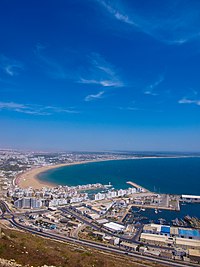List of cities in Morocco

The basic unit of local government in Morocco is the commune.[1] At the time of the 2014 population census, Morocco was divided into 1538 communes, 256 of which were classified as urban[2] and also called municipalities.[3] The remaining 1282 communes were classified as rural.[2] Urban centres were defined by the High Commission for Planning for some rural communes.[4]
The following list includes all Moroccan municipalities with 50,000 or more inhabitants according to the 2014 census,[a] as well as one urban centre of a rural commune whose population also exceeds 50,000 inhabitants. In its 2014 census report, the High Commission for Planning also published a list of the legal populations of seven major Moroccan cities, some of which comprise more than one administrative unit.[5] Those legal population figures are incorporated into the list, and the city definitions they are based upon are provided in the notes.
List of cities with 50,000 or more inhabitants
[edit]See also
[edit]- List of cities in Western Sahara
- List of metropolitan areas in Africa
- List of largest cities in the Arab world
Notes
[edit]- ^ Except Ouislane, which is legally defined as part of the city of Meknes: see note g.
- ^ In the 2014 census, the High Commission for Planning gave the legal population of Casablanca as 3,359,818,[5] which corresponds to the population of Casablanca Prefecture.[6]
- ^ In the 2014 census, the High Commission for Planning gave the legal population of Tangier as 947,952,[5] which corresponds to the combined population of the four arrondissements of Bni Makada, Charf-Mghogha, Charf-Souani and Tanger-Médina.[6]
- ^ In the 2014 census, the High Commission for Planning gave the legal population of Fez as 1,167,842,[5] which corresponds to the combined population of those parts of Fez Prefecture not within the cercle of Fez Banlieue ("suburbs").[6]
- ^ In the 2014 census, the High Commission for Planning gave the legal population of Marrakesh as 928,850,[5] which corresponds to the combined population of the municipality of Méchouar-Kasba and the five arrondissements of Annakhil, Gueliz, Marrakech-Médina, Ménara and Sidi Youssef Ben Ali.[6]
- ^ In the 2014 census, the High Commission for Planning gave the legal population of Salé as 890,403,[5] which corresponds to the combined population of the five arrondissements of Bab Lamrissa, Bettana, Hssaine, Layayda and Tabriquet.[6]
- ^ In the 2014 census, the High Commission for Planning gave the legal population of Meknes as 632,079,[5] which corresponds to the combined population of the municipalities of Meknes, Al Machouar – Stinia, Toulal and Ouislane.[6]
- ^ In the 2014 census, the High Commission for Planning gave the legal population of Rabat as 577,827,[5] which corresponds to the population of Rabat Prefecture.[6]
- ^ The population figure refers only to the urban centre (HCP geographic code 09.001.05.09.3) of the rural commune of Drargua.
References
[edit]- ^ "Titre IX. Des régions et des collectivités territoriales". Constitution of Morocco (in French). 1 July 2011. Retrieved 14 October 2017.
- ^ a b "Répartition géographique de la population d'après les données du Recensement Général de la Population et de l'Habitat de 2014" (in French). High Commission for Planning. Retrieved 14 October 2017.
- ^ "Resilience and Growth Through Sustained Adjustment: The Moroccan Experience". Occasional Paper 117. IMF: 19. January 1995. ISBN 1557754225. Retrieved 14 October 2017.
- ^ Démographie Marocaine: tendances passées et perspectives d'avenir (PDF) (in French). High Commission for Planning. 2005. ISBN 9954405283. Retrieved 14 October 2017.
- ^ a b c d e f g h i "Note de présentation des premiers résultats du Recensement Général de la Population et de l'Habitat 2014" (in French). High Commission for Planning. 20 March 2015. p. 8. Retrieved 9 October 2017.
- ^ a b c d e f g h "Population légale des régions, provinces, préfectures, municipalités, arrondissements et communes du royaume d'après les résultats du rgph 2014" (in Arabic and French). High Commission for Planning. 8 April 2015. Retrieved 29 September 2017.









